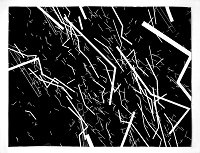
Lebbeus Woods, Conflict Space 3, 2006; crayon and acrylic on linen; 74 x 120 in. (187.96 x 304.8 cm); Collection SFMOMA, purchase through a gift of anonymous donors and the Accessions Committee Fund; © Lebbeus Woods
From September 1, 2012, through January 6, 2013, the San Francisco Museum of Modern Art (SFMOMA) presents an exhibition that bends and blurs the boundaries between conceptual art and theoretical architecture, using the notion of the “field” to frame an investigation into the construction, representation, and experience of space. Field Conditions aggregates nearly 30 works in various media by both contemporary artists and practicing architects, including Tauba Auerbach, Daniel Libeskind, Rafael Lozano-Hemmer, Sol LeWitt, and Lebbeus Woods, among others.
Curated by Joseph Becker, assistant curator of architecture and design at SFMOMA, Field Conditions demonstrates the inventive and interdisciplinary thinking that is a hallmark of SFMOMA’s architecture and design collection. Becker describes the projects in the exhibition as “spatial experiments”—regardless of whether their makers define themselves as architects or visual artists, “all use a kind of architectural language to describe or provoke a spatial condition.”
The exhibition takes its title from a landmark essay by architect Stan Allen. First published in 1996, Allen’s “Field Conditions” marked a move away from traditional concepts of architectural form and toward a consideration of systems and networks. The show draws upon Allen’s ideas in focusing on works that redefine the relationships between figure and ground, object and process, finite and infinite, place and nonplace. Here, the term “field” refers to an array of objects or marks that accumulate to the point of becoming a kind of system.
In a number of the works in Field Conditions, this cumulative or serial process takes the form of drawing. While a drawing by Allen himself—a vast array of algorithmically generated floor plans—has a practical yet abstract architectural application, the projects in the exhibition principally demonstrate ways of inscribing or describing space without the apparatus of a building. Daniel Libeskind’s Micromegas (1978), made early in the celebrated architect’s career and now in the SFMOMA collection, is a conceptual cornerstone of the exhibition, with its early and radical stance to the language of architecture. This deconstructionist approach opened new exploratory avenues for later architects and artists such as Lebbeus Woods, whose large-scale, immersive Conflict Space drawings (2006) will also be on view.
Many of the works in Field Conditions seem to defy the idea of boundary and act as windows into a potentially larger expanse, provoking viewers to imagine beyond the frame. In Sol LeWitt’s Wall Drawing #45 (1970), a significant instance of art as plan or system rather than object, the size of the artwork is determined by the dimensions of the wall. The work emphasizes the arbitrariness of the edge, suggesting that the drawing could extend infinitely beyond the surface it marks.
Similarly, Tauba Auerbach’s 50/50 Floor (2008) suggests a rectangle cut out of an infinite expanse. Covering the gallery floor with a grid randomly composed of 50 percent black and 50 percent white, the piece creates a walk-in field, one of a limitless number of possible configurations. Complementing 50/50 Floor is Auerbach’s Static 6 (2008), a photograph of TV “snow.” This representation of ambient electromagnetic waves visualizes the invisible, a process also suggested in 20Hz (2011), a video work by U.K. duo Semiconductor based on signals detected in outer space.
Like 50/50 Floor, Rafael Lozano-Hemmer’s Homographies (2006) brings the viewer inside a large-scale field. This interactive installation employs an overhead grid of fluorescent tubes programmed to rotate in response to visitors’ movements. As the lights react to the changing spatial relationships between people in the gallery, they denote disruptions in the field, creating interference in a homogeneous space. Lozano-Hemmer will also be the subject of a solo exhibition at SFMOMA this fall.
Among the other works featured in the exhibition are a new, large-scale drawing by Marsha Cottrell; two of the Cluster Diagrams (2001) by Bay Area–based architect Thom Faulders; a series of recent drawings by Austrian artist Peter Jellitsch; and a two-channel iterative media work by Los Angeles artist C. E. B. Reas.
Field Conditions is organized by the San Francisco Museum of Modern Art. In-kind support is provided by Daltile.